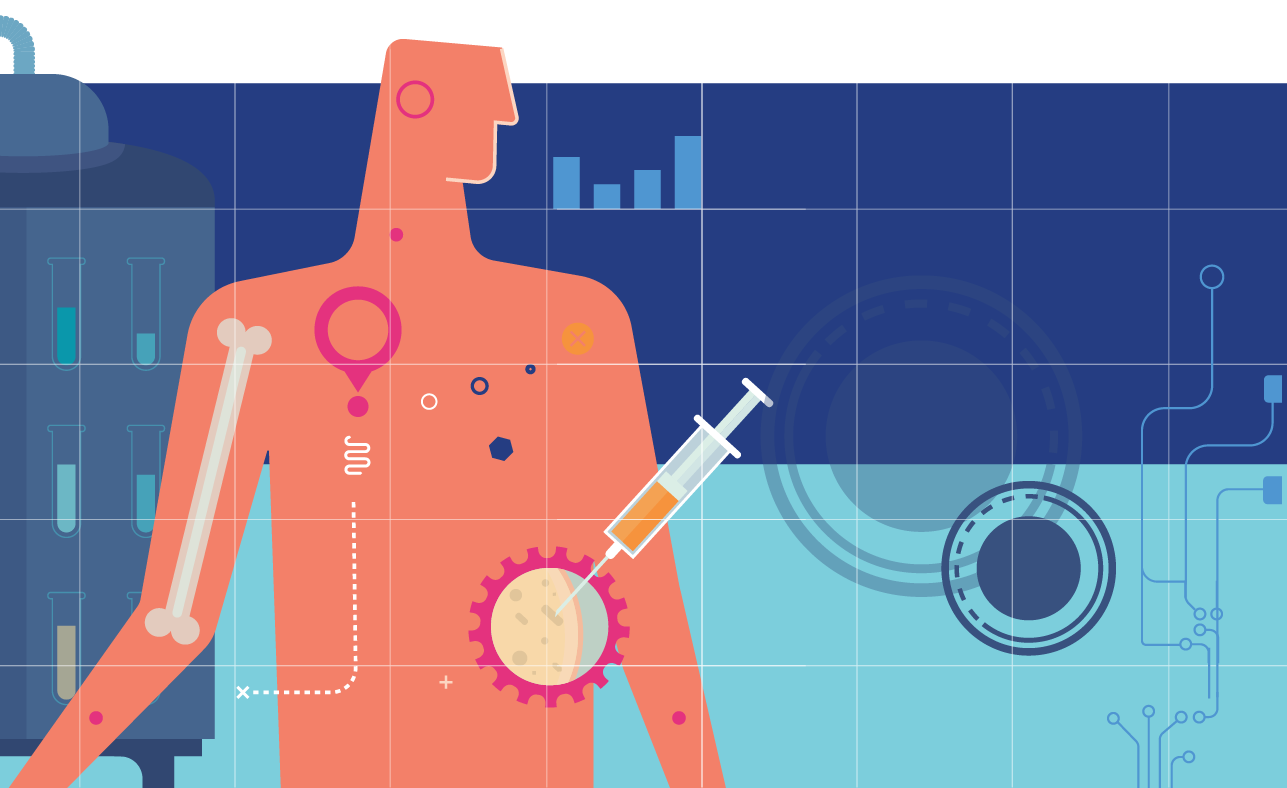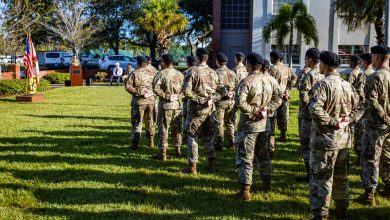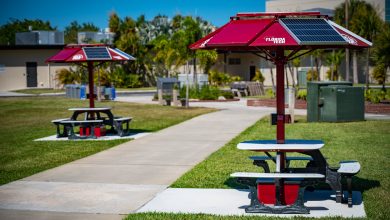Breaking into Biomed
A booming industry that is just getting started, biomedicine is shaping health care, society and the future—at Florida Tech and across the globe.
Scientists can sequence a person’s entire genome for $1,000.
Doctors can laser a kidney stone to extinction, navigating a patient’s body with live footage from microscopic cameras without a single incision.
Researchers can take a cell from a patient’s body, grow it in a dish, reprogram it to attack a tumor and transplant it back into the patient.
No, this isn’t science fiction. It’s biomedicine. And it is changing the world.
A relatively new field, biomedicine—a term first introduced in the 1930s, preceded by “biomedical” a decade earlier—incorporates the aspects of medicine derived from the natural sciences, particularly biology, biochemistry and biophysics.
Florida Tech offers undergraduate degrees in both biomedical science and biomedical engineering (also M.S. and Ph.D. biomedical engineering programs), as well as a master’s degree in biotechnology.
What’s the difference?
Where biomedical scientists are more interested in basic research discoveries and developing therapeutics—understanding, diagnosing and treating disease—biomedical engineers typically focus on practical solutions—creating new technologies with medical applications.
Essentially, biomedical science evaluates “What?” “How?” and “Why?” while biomedical engineering and biotechnology aim to answer, “How can we fix it?”
While becoming a doctor is a popular career path for biomed students, it is one of many intertwining options within the greater scope of health care.
Researchers make initial discoveries. Biotech companies translate those discoveries into therapies. Pharmaceutical companies formulate the next groundbreaking medications. Engineers design and create tangible medical tools and prosthetics. And physicians apply it all to benefit their patients.
Aside from science and engineering careers, a biomedical mindset has benefits in fields such as patent law (Who made the most critical discovery first?), business (What are the most promising advances to invest in?) and education and outreach (How do we close the disconnect between the basic sciences and the public’s appreciation of science?).

“Career paths in biomed really span the gamut,” says Eric Guisbert, an associate professor in Florida Tech’s biomedical and chemical engineering and sciences department, “and our alumni do it all.”
Nationwide, biomed is rapidly growing, with employment of biomedical engineers and scientists expected to grow by 10% and 17%, respectively, from 2021 to 2031—significantly faster than the average for all occupations, according to the U.S. Bureau of Labor Statistics.
Why?
Some attribute the increase to a demand for physicians—as the population ages, more people need more doctors.
Some recognize that as technology advances, so must its applications in all fields, including health care.
If you ask Guisbert, a biomedical scientist, it’s the desire to change people’s lives for the better that draws people to biomed.
“This is such an impactful part of everyone’s lives,” he says. “We want to do everything possible to help patients—those with Alzheimer’s, cancer and other diseases. It’s very rewarding because we’re doing something important. We’re trying to help humanity.”
The biomed boom is just beginning, and with proper nurture and collaboration, the Space Coast is poised to become a hub of biomedical innovation and advancement.
Florida Tech is leading the charge.
On campus, we have students conducting advanced biomedical research in areas such as regenerative medicine, tissue engineering, nanotechnology and more.
Administration is investing in cutting-edge resources and facilities, like the new Gordon L. Nelson Health Sciences building, which features 20,000 square feet of classrooms and labs, augmented and virtual reality teaching tools and more, and is expected to double the size of the biomedical engineering program and drastically increase the size of the undergraduate premedical program.
As Florida’s STEM university and home to the world-class Nathan M. Bisk College of Business, we are cultivating the next generation of both STEM-minded businesspeople and business-minded scientists and engineers to develop and market the next “big thing” in biomed.
With the know-how to attract investors to fund said “big thing,” are university-affiliated entrepreneurial organizations, such as weVENTURE Women’s Business Center. And with the resources to build and cultivate it, is the Center for Advanced Manufacturing and Innovative Design (CAMID), Florida Tech’s innovation accelerator that connects businesses of any size with advanced manufacturing resources and faculty expertise.
Factors such as these, paired with the university’s location in the heart of Florida’s high-tech corridor, have laid the groundwork for Florida Tech’s most recent step toward biomedical renown: an affiliation agreement with Burrell College of Osteopathic Medicine.
In its first year, the affiliation, announced in January, will bring 100 first-class medical students to campus, where they’ll receive a top-notch education from an established, reputable medical school fortified by access to Florida Tech’s state-of-the-art tools and facilities.
In a rapidly evolving industry with so many diverse yet connected facets, collaborations such as these present the opportunity to share not just equipment, but ultimately, ideas, vision, perspective.
Seeking some of this perspective, we spoke to a few Florida Tech alumni—now and forever, our most valuable contribution to the biomed industry—about the most impactful ways biomed is shaping health care, society and the future. »
Putting medicine in the patient’s hands.
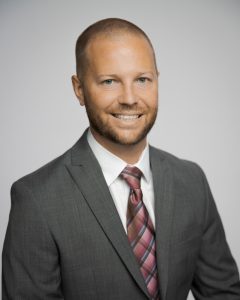
Wearable EKG and continuous glucose monitors, biosensors, smartwatches and fitness trackers enable you to check real-time health stats like heart rate, blood pressure, blood sugar and oxygen levels, sleep health and more with a quick glance at your cellphone—quite literally, putting your health in your own hands.

“Thanks to these new technologies, we’re seeing individuals’ health care being placed more so on the patients themselves, and physicians being the guide, but not necessarily the treater,” says Theodore Schuck ’16 MBA, a family medicine doctor and chief medical officer at Brevard Health Alliance. “You’re going to be your own best advocate for health care.”
Since he graduated from medical school over 10 years ago, Schuck, who earned his MBA in health care management from Florida Tech, has seen patient-guided treatment make its way to the forefront of health care. This, he says, is in response to both technological advancements and a general shift from acute care to more chronic disease management.
“People are living longer. So, they have to be able to manage some of these disease states that, unfortunately, we can’t cure, such as diabetes or heart disease,” he says. “So, it’s a matter of them being able to determine what they can do for their own health to feel better—whether it’s taking their medicines, exercising or just knowing their status, and then reporting those results to their primary care doctor.”
It’s important that we continue to grow from a technology standpoint. Like any other field, if we’re not making innovations and changes, then we’re not progressing.”
Theodore Schuck ’16 MBA, Health Care Management
Improving patient outcomes.
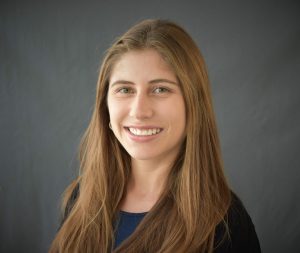
“How can we use our current resources to improve people’s lives?”
That is the question Pamela Forero ’17 continually strives to answer in her work as a process development engineer at Humacyte, a regenerative medicine company in Research Triangle Park in Durham, North Carolina.
Humacyte creates artificial blood vessels using human cells that scientists develop into tissue and implant into the body to restore blood flow.

Other options exist: an artificial blood vessel made from a synthetic graft or blood vessels extracted from a cadaver or another part of your body. But these either require additional surgery—posing additional risk—or have high infection rates—because the body rejects the unrecognized materials.
“We’ve worked with so many doctors who have told us, ‘Your product is going to change everything. It is saving lives,’” Forero says. “That is why I chose this career.”
Her work, Forero says, is never done. She and her team are continuously experimenting with ways to improve the process, working with scientists and engineers in several biomedical subfields with varying expertise.
“Take all the physics, all the chemistries, all the biologies, all the engineerings and apply those to the body—that’s what we do,” she says. “That’s the really cool thing about biomedical engineering. Everything is connected, and through collaboration, you can achieve something really, really mind-blowing.”
Biomedical engineering, despite its many years, is still a new field, and I don’t think we even know all of the things we are capable of because it just keeps growing and growing.”
Pamela Forero ’17, biomedical engineering
Personalizing medicine.
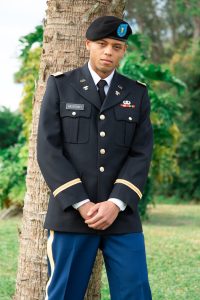
Before ever administering a therapeutic, scientists can know almost exactly how the treatment will affect your body—not a similar body. Not most bodies. Your body.
Isiah Mossiah ’20, ’21 M.S., is a research associate at Hesperos Inc., an Orlando company that uses human-on-a-chip® technology to conduct disease modeling and drug testing. According to Hesperos, human-on-a-chip is an “interconnected, reconfigurable, multi-organ in vitro platform reproducing the functional aspects of human physiology, providing unprecedented visibility into how the human body will respond to chemicals and novel therapeutics.”
One application of the human-on-a-chip system involves differentiating a patient’s cells that are affected by disease and placing them in a microfluidic chip in conjunction with other relevant organ types. Then, researchers, like Mossiah, test whether different treatments can restore function when compared to healthy cells, ultimately, allowing the patient and his or her doctor to administer the most safe and effective medications.
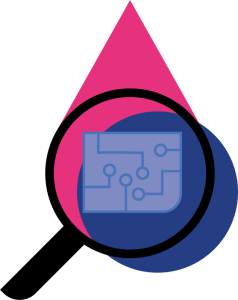
“Personalized medicine is essential to improving the quality of care people get, especially those with rare diseases,” Mossiah says. “Instead of giving patients something that could potentially help them, we can give them something that we know could help them because we tested it prior.”
While other labs conduct similar research, Hesperos is one of few that have commercialized the technology, transitioning it from academia to industry.
“Ever since we decoded the human genome—and that was a huge, huge discovery—now it’s just trying to figure out what genes do what in the body and using that information to develop therapies that can actually help people,” Mossiah says.
The future of biotech is having people and companies that are multidisciplinary, allowing them to maximize the biological applications they’re trying to study.”
Isiah Mossiah ’20, Genomics and Molecular Genetics; ’21 M.S., biotechnology
Enhancing the learning experience.
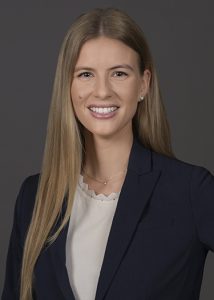
In her first year of medical school, Amanda Kahn ’18 was able to “run a code”: administer immediate resuscitative measures, like performing CPR and applying an AED, on a patient in sudden cardiopulmonary arrest.
Thankfully, she says, the patient was a simulation mannequin.
“It can be very overwhelming,” Kahn says. “So, to have the experience with a simulator in a safe educational space, where no one’s going to get hurt, and you can practice and mess up and it’s no big deal, is amazing.”
A fourth-year medical student at Florida International University in Miami, Kahn still remembers the lessons she learned on the simulator—a life-like human body with a heartbeat, a pulse and the ability to move its eyes, blink and have a seizure—and applies them in the hospital today.
In addition to simulators, advances in camera and robotic technology have really made it easier for students to study anatomy, she says.
The da Vinci surgical system, for example, is a robot that docks on top of a patient lying on an operating table. Its high-definition camera allows physicians-in-training to see everything the surgeon does from the surgeon’s viewpoint.

“As a med student, you’re the last person in line to have the best view in an open surgery,” Kahn says. “But now, I can sit in the corner of the operating room, not have to be scrubbed in or touching the patient, and I can see everything very clearly. It has really changed things for learners.”
Kahn is applying to the field of urology, a surgical field, and is interested in urologic oncology, minimally invasive surgery with robotics and endoscopic urology. She has seen firsthand how biomedical advances, like laser technology in noninvasive surgery, have improved the patient experience, as well.
“In urology, you really get to mix biotechnology, patient care and medicine, so I think it’s part of why I’m super interested in the field,” she says. “There’s always new technology coming out, always trying to get better, trying to improve.”
When I think of my community, I think of our patients—the people we’re here doing all of this for. I think the biomed industry has driven a lot of patient care improvements in the last 20 years, and I think it’s going to continue.”
Amanda Kahn ’18, Biological Sciences, Premed
This piece was featured in the winter 2023 edition of Florida Tech Magazine.

